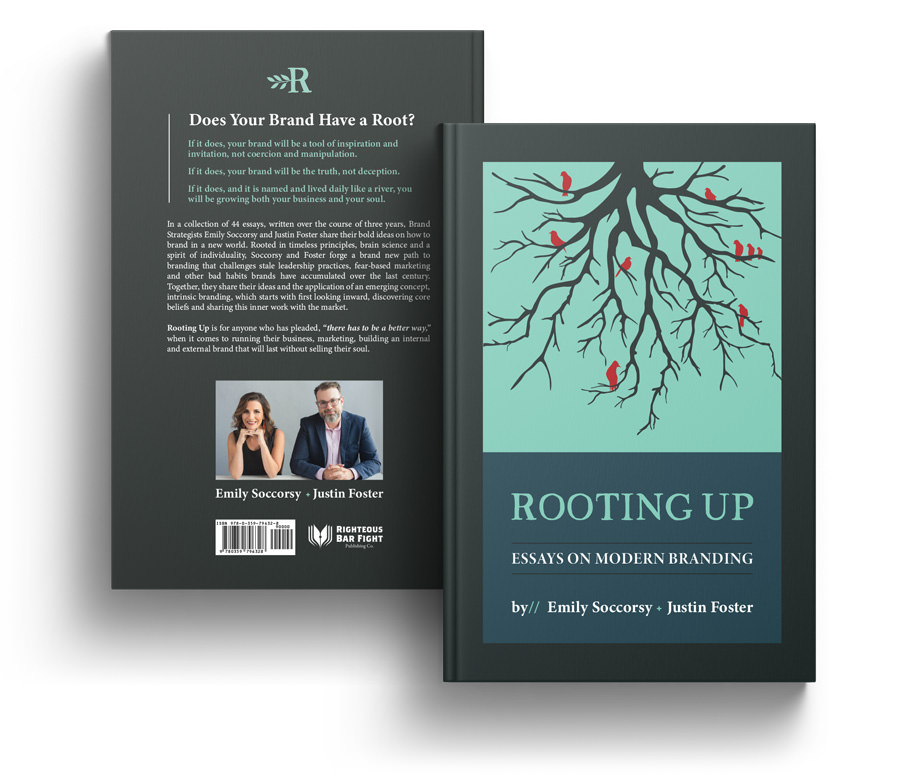Filed Under: 21st Century Branding
By Emily Soccorsy + Justin Foster
“I can’t work on my brand right now, I have business problems to deal with.”
“The goals for the business aren’t important or relevant to our brand.”
“Oh, we have an agency that handles all of that brand stuff.”
These are a few comments we’ve heard recently from owners and senior executives about their views on brands and branding.
Here’s the truth few branding or marketing agencies will tell you because it hurts their ability to sell you huge monthly retainers for months on end: your brand is just as important as your business model. Your brand IS your business model.
And understanding what your brand is, what it stands for, is essential to solving each and every business problem you face.
This is what we refer to as “brand-centric” thinking.
The idea of being brand-centric is not actually new. Beliefs, standards and differentiation were the standard practice prior to the industrial age. In short, if you made shoes, you couldn’t suck at making shoes or everyone would know. If you built leaky ships, it would hurt business. This is before ad agencies came along and started promoting the idea that you could build a brand separate from the business model. Even in the golden age of advertising, innovative leaders pushed back against making everything business- or product-centric.
Here’s an example: Disney has never been business model-centric. They have always been brand-centric. This has allowed them to build a robust culture and a diverse and high value portfolio of offerings in the marketplace.
Another example: IBM no longer sells “business machines” or computers. They are a now a service/consulting based organization. Yet their business is thriving because they were brand-centric in their approach. This allowed them to lift-and-shift to an entirely different business model without jeopardizing the future of the company.
Think of your brand as the foundation for all of your business decisions. Just like a building, the foundation prevents or causes the majority of serious problems that could arise. With a solid, even and consistent foundation, rooms can be added, other issues can be addressed and you all dwell within the framework of a sturdy, safe structure.
So we made the bold claim in our headline that a strong brand (foundation) solves a thousand business problems. Here are a few to consider:
Lack of Innovation: This is typically related to lack of innovation with products or services, or a general sense that a company is going stale. When you are brand-centric, innovation is a daily leadership habit and it is nurtured at all levels of an organization. When you are brand-centric, both your employees and customers become a large focus group/innovation lab pouring out improvements, new ideas and creativity. When you are brand-centric and you run into a lack of innovation, your go-to solution should be to ask these questions: What does our audience want from our brand? What do they expect of us? How can the brand they have come to trust provide them more?
Lack of New Business: This is typically related to ineffective customer acquisition efforts, lackluster flow of new leads, and deflated sales pipelines. These are all symptoms of a deeper problem: your brand and your products are boring. Your customers know it. Your employees know it. And in your gut, you know it. Being boring muffles the universal law of attraction. It can also be symptomatic of a disconnect between your people and your vision, which leads to a disconnect between your people and the people they serve — your customers. If your people cannot understand the soul of your brand they cannot transfer that soul into their work — and understand the soul of the need of your clients. When you have a powerful brand, none of these become long-term issues because decisions are made aligned with the best needs of the brand, not a short-term sales initiative, awareness campaign or new product launch.
Mythology of Perfection: The 20th century obsession with productivity has given way to the 21st century obsession with perfection. Everything has to primped, polished and presented in a way that creates “mass appeal” and in a way that also doesn’t offend anyone. Most of all, the obsession with perfection is found in leaders – with talk of putting on their “leadership face,” over-thinking about what to say, over-positioning and running yourself aground in a wave of big data analysis. Here’s the truth. Perfection is a myth. It is a myth born of being business model-centric that says that everything can be solved with a process and covered over with marketing. When you discard this myth, you and your brand get to be real, raw and authentic. All things that are craved by the marketplace.
So how do you know it’s time to become brand-centric? How do you know when it’s time to work on your brand? Well, the easy answer is “right now!” But the real answer is when your heart and the hearts of your leaders are ready to commit to what it takes to do this. If it is just an intellectual exercise or strategic initiative or an experiment, your heart won’t be in it and it will likely fail. Just like Walt Disney, you must have a powerful vision, an endless burning desire to innovate and a healthy obsession with the human experience.
Emily Soccorsy + Justin Foster are cofounders of the intrinsic branding practice known as Root + River. Together with their defiantly different clients, they uncover then articulate the foundational elements of the brand. Then, they provide brand strategy and brand coaching as the brand is rolled out internally and externally. Obsessive about language and differentiation, Emily + Justin are also authors and speakers. Follow @rootandriver @fosterthinking and @emilyatlarge.
